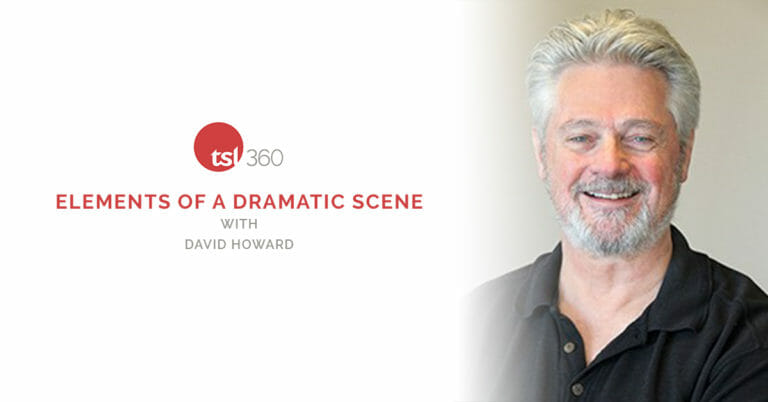By Valerie Kalfrin · April 14, 2019

A Civil War soldier wounded in battle, a prince with a debilitating stammer, and a black female mathematician at NASA in the 1960s all have something that speaks to audiences: courage.
“It’s one of the things that we tend to gravitate towards in characters. If they have the courage to keep going, if they are stubborn and keep going, they tend to make better characters,” said David Howard, professor and former chair at USC’s School of Cinematic Arts graduate screenwriting program. “So if you have a character who is relentlessly cowardly, we have to find a way to force them into circumstances where they have to find their courage.”
Howard discussed each of the memorable protagonists above—from 1990’s Dances With Wolves, 2010’s The King’s Speech, and 2016’s Hidden Figures, respectively—in his TSL 360 video. He dissected how individual scenes from these films show that courage and hold audiences rapt.
Stories take place in what Howard calls “the almost future,” piquing our interest in what happens next. A story and characters can fall flat when screenwriters rely on backstory, montages, exposition, and dialogue.
“This character wants something; I don’t know whether he’s going to be able to do it or not,” he said. “Our first impetus always is just to have a character say what they want, what they’re feeling, all of that. It’s always less convincing than it is when we see it taken in action.”
Here, Howard shares six elements that will elevate your scenes, build audience anticipation, and put viewers in a character’s corner. Hear him dive into more detail with a TSL 360 membership. TSL 360 also grants you access to dozens of masterclasses, interviews, and lectures from Academy Award-winning screenwriters, Emmy-winning TV writers, producers, agents, and major studio executives.
For circumstances to be dramatic, we need a specific setting. “What’s the context within which a scene happens? This is one of the things that beginning screenwriters often fail at. They say, ‘Office.’ ‘Street.’ Know where my all-time favorite scene heading is? ‘Exterior – Russia. Day.’ OK, just think of the DP [director of photography] trying to light that, you know?” Howard said.
The first scene he examined occurs toward the beginning of Dances With Wolves, set in a medical tent on a Civil War battlefield. Two surgeons in blood-spattered aprons wrestle off a soldier’s boot, toss it into a pile of other boots, and break for coffee:
A character’s nature appears through conflict. “The stronger the conflict, the more likely we are to understand or get a handle on who the character is in reality. … How do they respond to difficult things?”
Putting a specific person into a particular location adds to a character’s obstacles and automatically intrigues us.
In Dances With Wolves, after the exhausted surgeons leave the tent, Lt. John Dunbar (director and star Kevin Costner) sits up. We don’t yet know his name, but we watch him see implements of amputation next to his cot, as well as a soldier outside, balancing on one leg and crutches.
A scene becomes visceral when we recognize a specific character’s goal in a specific setting. “The irony of that [is], most of my students at USC at first rebel against it. [But] it’s that specificity that enables universal connection,” Howard said.
Dunbar uses a stick to retrieve his bloody boot from the pile, tries to slide it on, and cries out in agony. He then breaks the stick in half, bites down on it to mask his cries, and slides the boot on fully before falling backward in pain.
“I suspect we’ve never been shot in the foot, never had a broken foot, never had to pull a boot on to a broken foot, but we can all identify because of the specificity of who he is,” Howard said. “He’s not saying, ‘Gee, what I really want is to save my own foot.’ He is making this decision that we understand because we understand the circumstances … So we have a little resolution of what he was in pursuit of, right then and there.”
If we’re connected with a character, we tend to anticipate where the story goes. “We show [viewers] what the character has to think about; we trigger in some way the decision that they make when they take an action based on that decision,” Howard said.
When we watch that character take action, “we feel as if we’re reading their mind.”
Probably the most common enemy of drama that Howard notices in early screenplays is too much dialogue, when characters say what they want. “There is no action toward a goal other than talking, and we tend not to believe talking nearly as much as what somebody does,” he said.
Build tension and anticipation in a scene by managing time. In The King’s Speech, when Prince Albert (Colin Firth), Duke of York, the second son of King George V, must address the crowd at the British Empire Exhibition at Wembley Stadium in the 1930s, his hesitancy and embarrassment at the microphone seem to last beyond real time.
A good story, as Hitchcock and others have said, is life without the boring parts, Howard noted. “But we also elaborate on the really interesting part, and here the humiliation, the terror that he feels—that’s the part that needs elaborating on,” something also highlighted in Dances With Wolves as Dunbar retrieves and puts on his boot.
“We want to have control over time so that the maximum amount of screen time is given to the most important things,” Howard said.
In skipping over the boring parts, don’t jump over your characters’ decisive moments, Howard said. Let us see them wrestle with what they should do.
“Where drama really lives is in the moments of decision, when a character thinks on their feet and we can see it and we can feel it with them. That’s when we have our closest connection, when the window opens it to the inner life of that character,” Howard said.
Staying in those uncomfortable moments also lets the audience work a bit. “We give them the tools. We give them the information. We give them that moment of decision, and then we just don’t say it. We make them figure it out.”
Securing Distribution for Your Film with Alexandra Boylan
The 11 Fundamental Questions with Aaron Mendelsohn
7 Strategies for ‘Producing People’ and Being a Great Producer with Kristen Murtha
8 Keys to Unlocking Hollywood Gatekeepers from Producer Sandra Leviton
4 Top Reps Reveal How to Get an Agent or Manager

 Valerie Kalfrin is an award-winning crime journalist who now dives into fictional mayhem as an author (Quicklet on The Closer: Season 1), essayist, film critic, screenwriter, and emerging script consultant. She also writes for The Guardian, Bright Wall Dark Room, ScreenCraft, Hazlitt, Signature, and the blog for Final Draft, the top-rated screenwriting software used by the filmmaking industry. A member of Screenwriters of Tomorrow, she’s collaborated on short films and features, and she’s affiliated with the Tampa Bay Film Society. She lives in Florida. Find her online at valeriekalfrin.com.
Valerie Kalfrin is an award-winning crime journalist who now dives into fictional mayhem as an author (Quicklet on The Closer: Season 1), essayist, film critic, screenwriter, and emerging script consultant. She also writes for The Guardian, Bright Wall Dark Room, ScreenCraft, Hazlitt, Signature, and the blog for Final Draft, the top-rated screenwriting software used by the filmmaking industry. A member of Screenwriters of Tomorrow, she’s collaborated on short films and features, and she’s affiliated with the Tampa Bay Film Society. She lives in Florida. Find her online at valeriekalfrin.com.
For all the latest from The Script Lab, be sure to follow us on Twitter, Facebook, and Instagram.